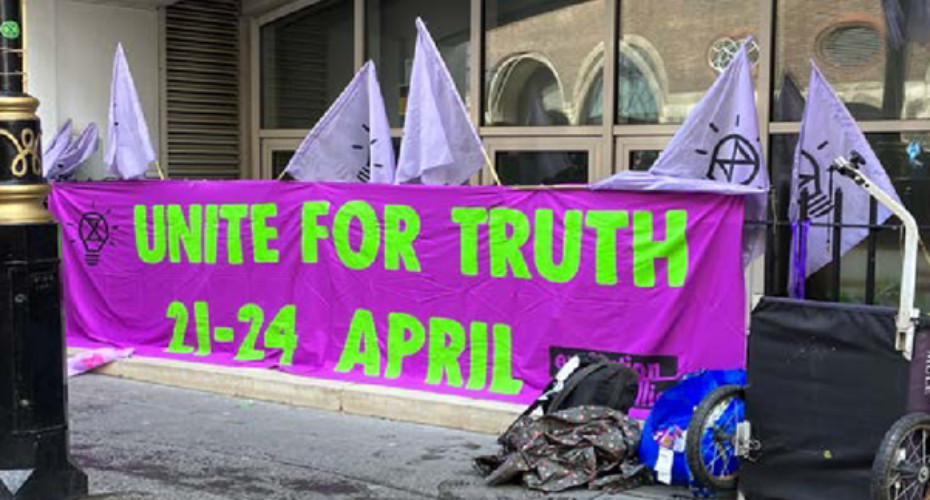“Significant work” needed to involve Black and Asian communities in environmental demonstrations, study says

Professor Clare Saunders and her team received survey responses from 611 The Big One participants
“Significant work” is needed to ensure Black and Asian communities are more involved in environmental protests, a new report says.
In the winter of 2022, Extinction Rebellion decided to change its tactics, moving away from disruptive blockades to more publicly acceptable forms of action to build a broad-based movement. Experts carried out research to see if the organisation was succeeding in its attempt to broader its supporter base.
Analysis of participants attending the April 2023 peaceful 4-day 50,000-strong “The Big One” protest showed BIPOC participants were better represented than in previous Extinction Rebellion demonstrations.
Overall, though, BAME participants, apart from those who are mixed-race, remained under-represented compared to the make-up of the UK population.
A total of 89 per cent of participants who were randomly sampled for a survey response were white (compared 83.4 per cent in the general UK population), 0.4 per cent were Black (compared to 4 per cent in the UK), 2.7 per cent were Asian / Asian British (compared to 9.3 per cent of the general public) and 7.5 per cent were mixed race (compared to just 2.2 per cent of the UK public).
Professor Clare Saunders, from the Department of Humanities and Social Sciences, Cornwall at the University of Exeter, and her team received survey responses from 611 The Big One participants and took special measures to ensure random sampling and to reduce response rate bias.
Professor Saunders said: “Participants felt that TBO was effective at reaching a diverse public, but there is more work to do here. Green and Labour Party supporters are over-represented and Black and Asian communities are still under-represented. There is significant work to be done with and through Black and Asian community networks and local political parties.”
More than half – 57 per cent – of those who took part in the demonstration had participated in climate change demonstrations less than five times before, and 18 per cent were first-time climate change demonstrators.
Participants thought the demonstration was relatively successful at attracting a diverse array of supporters and at illustrating the value of non-violent-direct-action. They were less convinced of its ability to persuade the government to adopt better policies or employ climate citizens’ assemblies, or to persuade bystanders of the importance of the cause.
The majority of participants were active in environmental organisations, and nearly half of them in community organisations – markedly lower than at previous climate change demonstrations and rebellions.
Taking part in low-risk forms of political action, for example petitions and ethical consumerism – was common among participants, with slightly higher numbers claiming to be more likely to participate in these after their participation in the event. Violent forms of action were unpopular.
Participants had a median income almost matching the UK’s, but reported a range of income categories, employment situations and job roles. Nearly one-third were in full-time work, just over one-fifth were self-employed, and just under one-fifth were in part-time work. A significant proportion were retired. There were relatively few students and homemakers.
Bristol, Oxford and parts of London – areas with strong Green Party support – drew some of the highest numbers of participants.
Participants who took part in the research named 55 different organisations of which they were members. The most frequently mentioned organisations are Extinction Rebellion (41.2 per cent), Greenpeace (12.9 per cent), Friends of the Earth (3.5 per cent) and Just Stop Oil (2.9 per cent). Numbers of people with membership of Just Stop Oil were significantly lower than the numbers of people who mentioned it as a key organisation staging the demonstration.
Professor Saunders said: “A total of 60 per cent of participants felt that TBO was very or extremely successful in terms of generating a diverse range of supporters. They were most sceptical about the ability of TBO to influence the government, both in relation to persuading it to take climate change seriously and encouraging it to institute independent citizen assemblies. Nearly two-thirds said they thought TBO was not at all or only slightly effective at persuading the government to take climate change seriously, and nearly three quarters thought the same about TBO’s ability to persuade the government to institute independent citizens’ assemblies.”
Many TBO participants were keen to support Extinction Rebellion mass demonstrations in the future: 92 per cent claimed that they were quite or very much likely to do so. Slightly fewer were keen to follow up on The Big One demonstration with participation in public outreach at events (49 per cent quite or very much) and in the community (45 per cent).
Participants were very highly educated. Eighty five percent had either completed or were engaging in university-level education. Nearly half had a university degree as their highest level of education, 28 per cent had a Masters, and 8 per cent a PhD. This is broadly comparable to the educational profiles of those attending UK climate marches and previous London Extinction Rebellion protests.
A full copy of the report is available here.



